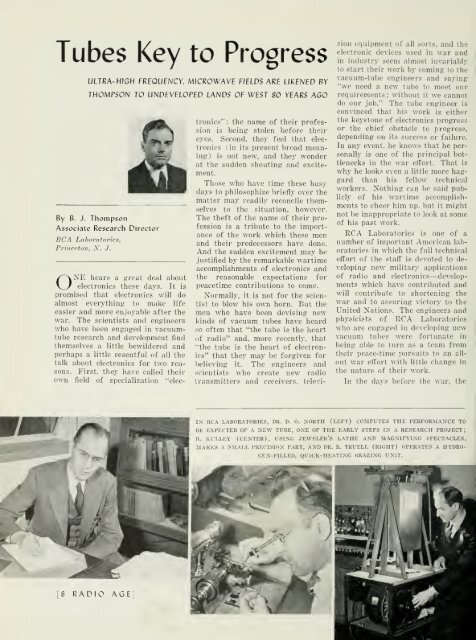Radio Age - 1944, January - 36 Pages, 3.3 MB ... - VacuumTubeEra
Radio Age - 1944, January - 36 Pages, 3.3 MB ... - VacuumTubeEra
Radio Age - 1944, January - 36 Pages, 3.3 MB ... - VacuumTubeEra
Create successful ePaper yourself
Turn your PDF publications into a flip-book with our unique Google optimized e-Paper software.
in<br />
Tubes Key to Progress<br />
ULTRA- H/GH FREQUENCY. MICROWAVE FIELDS ARE LIKENED BY<br />
THOMPSON TO UNDEVELOPED LANDS OF WEST 80 YEARS AGO<br />
By B. J. Thompson<br />
Associate Research Director<br />
RCA Laboratories,<br />
Princeton, N. J.<br />
ONE<br />
hears a great deal about<br />
electronics these days. It is<br />
promised that electronics will do<br />
almost everything- to make life<br />
easier and more enjoyable after the<br />
war. The scientists and engineers<br />
who have been engaged in vacuumtube<br />
research and development find<br />
themselves a little bewildered and<br />
perhaps a little resentful of all the<br />
talk about electronics for two reasons.<br />
First, they have called their<br />
own field of specialization "electronics":<br />
the name of their profession<br />
is being stolen before their<br />
eyes. Second, they feel that electronics<br />
its present broad<br />
I<br />
meaning)<br />
is not new, and they wonder<br />
at the sudden shouting and excitement.<br />
Those who have time these busy<br />
days to philosophize briefly over the<br />
matter may readily reconcile themselves<br />
to the situation, however.<br />
The theft of the name of their profession<br />
is a tribute to the importance<br />
of the work which these men<br />
and their predecessors have done.<br />
And the sudden excitement may be<br />
justified by the remarkable wartime<br />
accomplishments of electronics and<br />
the reasonable expectations for<br />
peacetime contributions to come.<br />
Normally, it is not for the scientist<br />
to blow his own horn. But the<br />
men who have been devising new<br />
kinds of vacuum tubes have heard<br />
so often that "the tube is the heart<br />
of radio" and, more recently, that<br />
"the tube is the heart of electronics"<br />
that they may be forgiven for<br />
believing it. The engineers and<br />
scientists who create new radio<br />
transmitters and receivers, television<br />
equipment of all sorts, and the<br />
electronic devices used in war and<br />
in industry seem almost invariably<br />
to start their work by coming to the<br />
vacuum-tube engineers and saying<br />
"we need a new tube to meet our<br />
requirements; without it we cannot<br />
do our job." The tube engineer is<br />
convinced that his work is either<br />
the keystone of electronics progress<br />
or the chief obstacle to progress,<br />
depending on its success or failure.<br />
In any event, he knows that he personally<br />
is one of the principal bottlenecks<br />
in the war effort. That is<br />
why he looks even a little more haggard<br />
than his fellow technical<br />
workers. Nothing can be said publicly<br />
of his wartime accomplishments<br />
to cheer him up. but it might<br />
not be inappropriate to look at some<br />
of his past work.<br />
RCA Laboratories is one of a<br />
number of important American laboratories<br />
in which the full technical<br />
eflfort of the staff is devoted to developing<br />
new military applications<br />
of radio and electronics—developments<br />
which have contributed and<br />
will contribute to shortening the<br />
war and to assuring victory to the<br />
United Nations. The engineers and<br />
physicists of RCA Laboratories<br />
who are engaged in developing new<br />
vacuum tubes were fortunate in<br />
being able to turn as a team from<br />
their peace-time pursuits to an allout<br />
war effort with little change in<br />
the nature of their work.<br />
In the davs before the war, the<br />
IN RC.'V LABORATORIES, DR. D. 0. NORTH (LEFT) COMPUTES THE PERFORMANCE TO<br />
BE EXPECTED OF A NEW TUBE, ONE OF THE E.VRLY STEPS IN A RESEARCH PROJECT;<br />
B. KULLEY (CENTER), USING JEWELER'S LATHE AND MAGNIFYING SPECTACLES,<br />
MAKES A SMALL PRECISION PART, AND DK. R. TRUELL (RIGHT) OPERATES A HYDRO-<br />
GEN-FILLED, QUICK-HEATING BRAZING U.MT.<br />
[8 RADIO AGE]
















